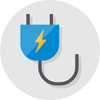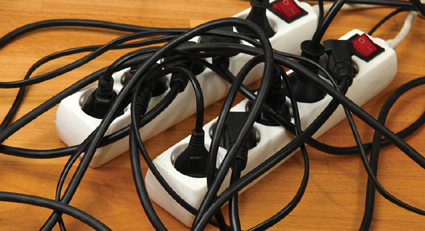
You turn off the lights when you leave a room, unplug your appliances when you go on vacation, and run the dishwasher and the washing machine only when they’re full. But your electricity bill is still sky high! What more can you possibly do to eliminate wasted electricity and bring those costs down? A surprising amount, it turns out! Start with these three golden rules:
How many clocks are there in your home? How many TVs? Computers? Refrigerators? Cell-phone chargers? The national averages are growing for each. For example, we now average more than three televisions per household, and today, that often means multiple cable boxes, DVD players, game units, and sound systems. If you are serious about cutting electricity costs, you need to simplify. Live with one refrigerator and one freezer. Share a laptop and a single printer. Use a wristwatch and unplug clocks. Be a one-television home. You’ll not only cut bills substantially, but you’ll also find life might get a little simpler and more enjoyable!
Many homes today have aquariums that have at least three electrical attachments in constant use (lights, heater, and pump). Some homes also have water fountains, dehumidifiers in the summer and humidifiers in the winter, electrical fences for their outdoor pets, elaborate outdoor lights on timers, and more. Turn a few off—or merely use them less often—and you can save a surprisingly large amount of cash on your electricity bill. Review all the functions and machines you have been operating automatically, and second-guess your need for them to be on so much.
Even when computers, microwaves, and many other appliances and electronics are turned off, they still have clocks, lights, and other functions that require electricity. So do this test: Take a nighttime, lights-off walk through your home, and count how many household machines are glowing. In the morning, do all you can to cut back on the glow. Turn the clock off on the microwave oven; power down your computer and its peripherals using a single power strip with an on-off button; unplug kitchen appliances you don’t use daily. Shutting down and unplugging will save more in electricity than you might think!

Now turn your attention to the smaller—but equally important—no-cost ways to eliminate electrical waste and bring your electrical costs back down to Earth. Try these quick-and-easy money- and electricity-saving strategies for your washer and dryer, oven, air conditioner, lights, and more.
✓ In the laundry room
Wash cold. Wash the majority of your clothes in cold water instead of warm or hot. According to the Alliance to Save Energy, an energy efficiency organization, this easy change can save up to $63 per year for the average consumer. Air-dry clothes, if you can, for considerably more savings.
Lose the lint. If you must dry clothes in a dryer, always clean the lint filter after every load to maintain peak drying efficiency.
Separate heavy from light. Dry towels, bedspreads, and other heavy items separately from lighter-weight items to increase drying efficiency. A dryer will keep drying until the wettest, heaviest item is done. Sure is wasteful if one beach towel is keeping the dryer going when everything else in the load is dry and ready! Also, try drying loads of clothing made out of similar fabrics, since one type of fabric can take twice as long to dry as another.
✓ In the kitchen
Place your refrigerator strategically. Keep your refrigerator away from your stove or heating vents. Otherwise, the fridge will have to work hard to stay cold . . . and you’ll pay extra money for that.
Microwave it. Microwaves use just 20 percent of the energy that conventional ovens require, and the likes of sweet potatoes and baked apples will taste every bit as good—as will all frozen foods.
Dispose of high bills. Run your food disposal with cold water. The cold water solidifies grease; the disposal then grinds it up and washes it down the pipes. You’ll save money on plumbing bills, as well as on hot-water costs!
✓ In the bathroom
Test your showerhead. Time how long it takes to fill a gallon bucket. If it’s less than 20 seconds, replace your showerhead with a low-flow model. This type of showerhead uses from 25 to 50 percent less hot water—and cuts down your water and heating costs.
Fix the drip. Is your faucet dripping warm or hot water? Fix it or get it fixed right away. Those little drops of water can add up—to 15 gallons of hot water a day. You’re needlessly adding to your heating and water costs.
Turn the fan off. In the winter, a hard-working bathroom fan can suck the warm air out of the average house in just one hour, according to the Department of Energy. Turn off your bathroom fan—and your range hood fan, for that matter—as soon as it has finished its job.
✓ Lighting
Leave the lights on. You may already know that compact fluorescent lights (CFLs) use about 75 percent less energy than standard incandescent light bulbs and can last up to ten times longer. What you may not know: Turning off CFLs when exiting a room for less than 15 minutes costs more than leaving them on. So if you are likely to be back in that part of your house within a quarter hour, leave the lights on to save!
Use task lighting. Why pay to brightly light an entire room if you’re working in just a portion of it? Instead, try focusing light only where you need it: on your desk when paying bills in your home office, under the kitchen cabinets when chopping ingredients for dinner, or on a side table when reading in bed.
Three is better than one. Put three-way bulbs into as many lamps as possible (assuming you’re not using CFLs). This type of bulb helps you keep lighting levels lower when you really don’t need bright light.
✓ Air conditioners
Clean or replace your filters. A dirty filter makes your air conditioner work harder while pumping out air that’s less cool. Either buy a replaceable filter that you can remove and vacuum every 3 to 4 weeks or front the cash for new filters—at about $5 each, a small price to pay for electric bills that won’t break the bank.
Don’t pay to cool the basement. Shut floor heating vents in the summer if you use window or wall air conditioners. Otherwise, the cool air you’re paying for will flow down through the ducts into the basement.
Keep the air dry for savings. An air conditioner removes humidity from the air, as well as cools your house. The less humidity in the air, the less your air conditioner has to work. Give your air conditioner a helping hand by not adding unnecessary moisture to the air—try not to bathe, wash clothes, or cook in the middle of the day, when your air conditioner is working its hardest.
Many appliances that use electricity in your house—including your television, computer, and dishwasher—continue to draw power even when they’re turned off. In fact, 75 percent of the electricity used for home electronics in the average home is drawn when these appliances are switched off. What can you do to keep from paying for an appliance you’re not using? You can either unplug the appliance or plug it into a power strip and then turn off the power switch, thereby cutting off the power to the appliance.